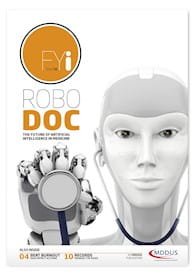 WHETHER it is recording your
interaction with a new
patient, documenting a ward
round or assessing a patient
individually, trainee doctors’
clinical entries form the
cornerstone of the medical records for most
patients in the hospital. You may not be at the
top of the clinical pecking order but your role is
critical in ensuring the wider healthcare team
is aware of the ongoing management of each
patient and delivers effective care.
WHETHER it is recording your
interaction with a new
patient, documenting a ward
round or assessing a patient
individually, trainee doctors’
clinical entries form the
cornerstone of the medical records for most
patients in the hospital. You may not be at the
top of the clinical pecking order but your role is
critical in ensuring the wider healthcare team
is aware of the ongoing management of each
patient and delivers effective care.
While your schedule is most likely hectic with barely a chance to stop for a bite to eat, taking time to keep clear and comprehensive notes is crucial. Here are some common risk areas to look out for.
Keep it legible
Most doctors have reviewed medical records containing hard-to-decipher scrawled handwriting. Or perhaps they are littered with abbreviations you have never seen before which could have multiple meanings. Entries like these are unhelpful and potentially harmful to the patient if misinterpreted. Next time you come across one, try to identify the author and seek clarification from them. Alternatively, ask a colleague to review it with you and always consider if what you believe is written would be clinically appropriate for that patient. It is all too easy during a busy shift to follow a documented action plan blindly.
MDDUS recently dealt with a case in which a patient was inadvertently prescribed 10 times the suggested warfarin dosage by an FY doctor who had misread a medical entry and didn’t notice the previously prescribed doses. Fortunately the error was detected in time by the nursing staff.
If you are writing in a medical record, think about how easy it will be for other healthcare professionals (doctors, nurses, pharmacists etc) to read and understand. Patients may also request access, so keep your entry objective and professional. One FY doctor found themselves in an embarrassing situation after they were asked by a patient to explain a written note stating that he was “a nightmare”.
MDDUS has also encountered several cases in which nursing staff have misread an FY doctor’s prescription, resulting in a medication error. This often occurs when a doctor has attempted to write a new dosage on top of the original entry, rather than rewriting it entirely.
It is also worthwhile to keep in mind that your medical entry may be reviewed many years down the line. For example, a patient may make a claim of negligence or there may be an investigation into an alleged misdiagnosis. It is therefore really helpful if you can print your name after you sign your medical entry and ideally include your GMC number. Many doctors carry a stamp with their name and GMC details as a useful timesaver.
Although not essential, try to make your entry in black ink. This is less likely to fade over time and is also easier to read if the records are photocopied.
Keep it accurate
Remember the medical record you make is sometimes the only available reflection of your actions and rationale. You should therefore take care to ensure that your entry is clear and unambiguous.
MDDUS recently dealt with a case in which a junior doctor was asked out-of-hours if a drain could be removed from a postoperative patient. The patient himself said he was told during the ward round that it could come out. The doctor reviewed the medical records and could only find a “tick” next to the word “drain” in the last medical entry. She presumed this meant it could come out and agreed. However, the intended plan was to keep it in and the tick was to represent the fact that it was draining well. The patient had to have the drain reinserted under ultrasound the following day and complained to the hospital. The FY doctor making the clinical entry could have assisted their colleague by providing a more detailed medical entry. As for the doctor reviewing the entry, she accepted that it was unclear and it may have been more prudent to clarify the meaning with a senior colleague.
Another, rather unfortunate case involved an FY doctor who wrote down blood test results for several patients on peel-off labels to save time. He had intended to stick each label into the appropriate medical records, but inadvertently mixed up two of them. The patient was then deemed unfit for theatre by a consultant due to abnormal liver function tests before the error was spotted by another team member.
Take your time
There is often the temptation, particularly when times are busy, to skim over relevant parts of the clinical history, examination or management plan. This is especially likely during a busy ward round when you are expected to obtain relevant test results and arrange additional investigations at the same time as documenting the contents of the round. In circumstances like these it is important to take your time and not allow anyone to rush you.
If you feel pressured, ask a senior colleague for help. Remember they have also been in your position and it is far better to seek assistance than risk making a mistake. It may also be helpful to ask the consultant or senior colleague undertaking a ward round to review your entry to ensure you have covered the key points. As well as assisting you and the ongoing care of the patient, it is in their own interests to ensure their input has been accurately documented.
Think beyond the notes
The records you keep about a patient are not restricted to their medical records. They include everything from your handover sheet and list of outstanding jobs to the blood test results you have jotted down to file in the notes. Any information from which a patient can be identified is also subject to the requirement of the Data Protection Act 2018 and General Data Protection Regulation (GDPR). You should therefore think carefully about the information you carry around about patients, how you store it, and whether it is identifiable. Once you have finished your shift and handed over, make sure you dispose of any handover or job lists securely.
MDDUS recently assisted an FY doctor who was the subject of an adverse incident investigation after throwing their handover list into the ward reception bin. The handover list noted the patients’ initials, their bed number and their outstanding medical needs. The doctor had thought that this did not constitute sensitive patient data as the patients’ full names were not used. However, when taken together as a whole, there was sufficient information to make each patient identifiable, and the Trust regarded it as a serious data breach.
So while it often takes a little more time to record an accurate, clear medical entry, the benefits in terms of risk management far outweigh the additional effort involved.
Dr Naeem Nazem is a medical adviser at MDDUS and editor of FYi
This page was correct at the time of publication. Any guidance is intended as general guidance for members only. If you are a member and need specific advice relating to your own circumstances, please contact one of our advisers.
Read more from this issue of FYi

Save this article
Save this article to a list of favourite articles which members can access in their account.
Save to library